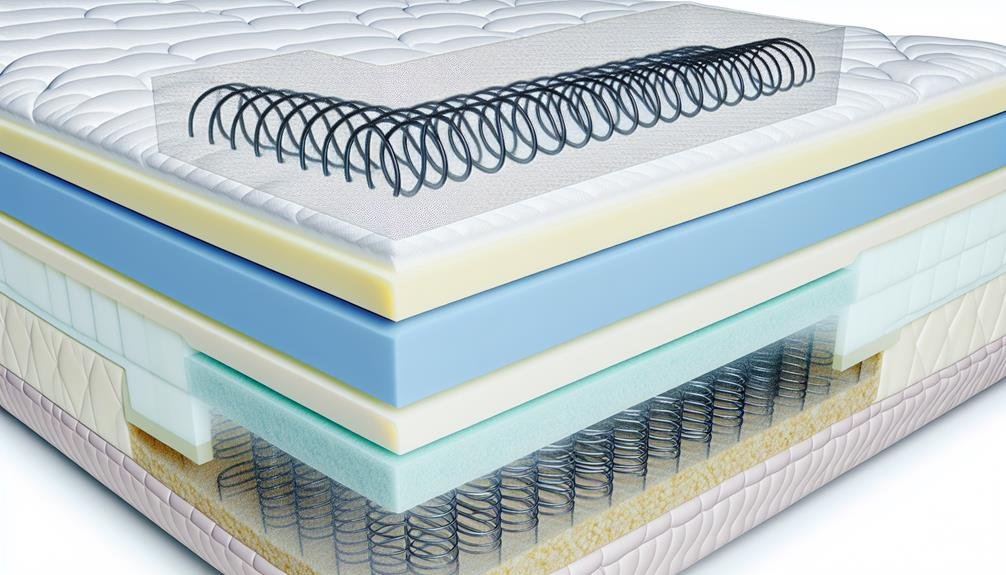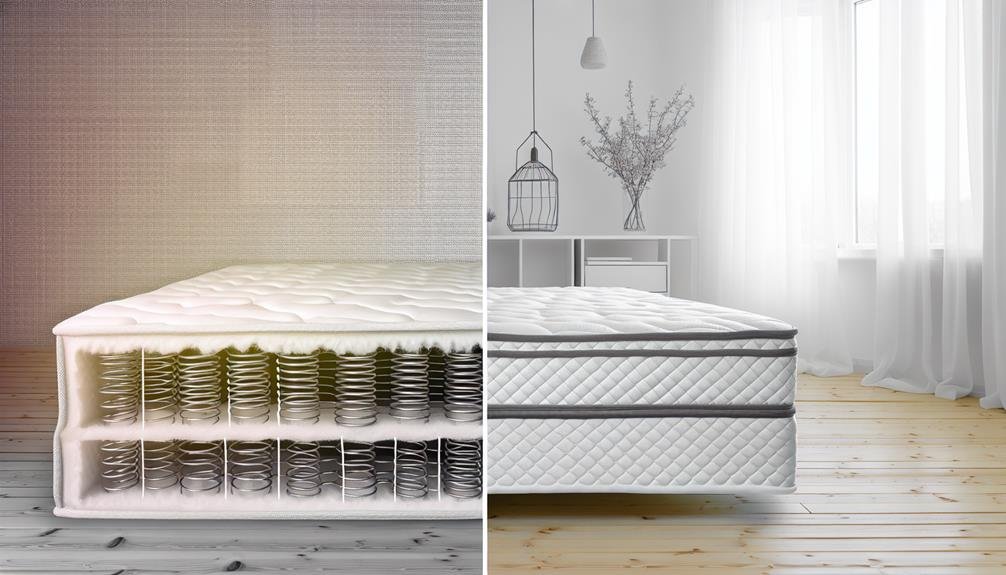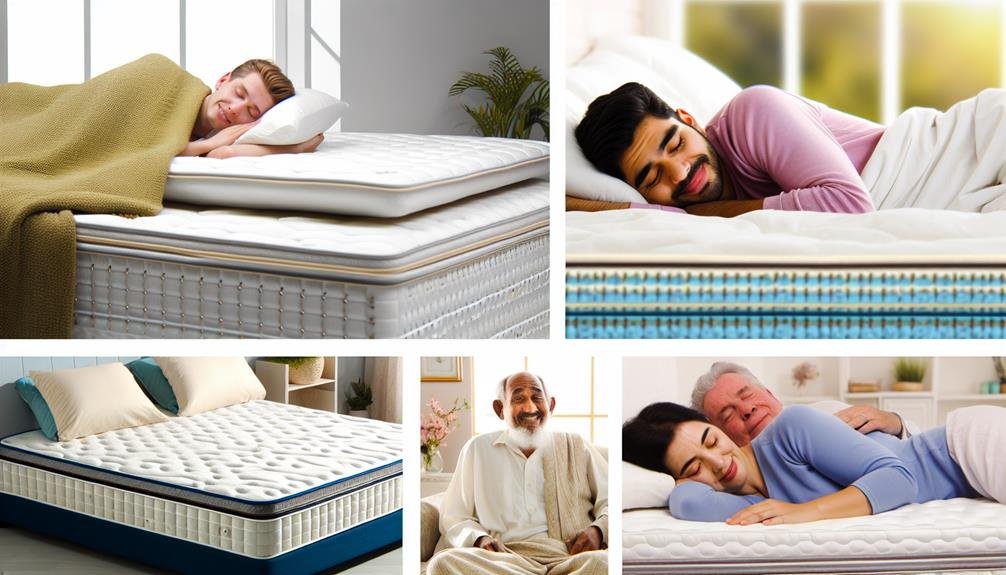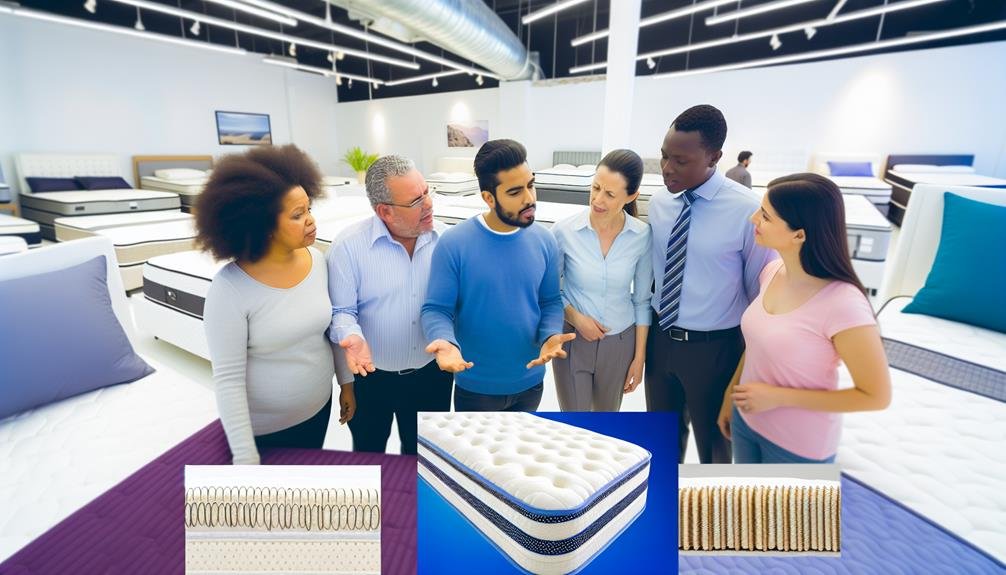In the quest for the perfect night's sleep, the choice of mattress plays a pivotal role, particularly when considering the unique attributes of innerspring models. Known for their traditional coil support systems, these mattresses offer a distinctive balance of comfort and support that can cater to a wide range of sleeping styles and preferences. However, with the myriad of options available in the market, selecting the right innerspring mattress becomes a task that demands a deeper understanding of its construction, benefits, and potential drawbacks. As we explore these aspects, one might wonder how these traditional components stand against modern innovations in mattress technology.

An innerspring mattress, typically referred to as a spring mattress, utilizes a coil-based support system designed to provide substantial body support during sleep. This supportive design incorporates a network of interconnected coils, known for their coil construction, which forms the core foundation of the mattress. These coils are engineered to distribute weight evenly and reduce motion transfer, enhancing the sleep benefits by minimizing sleep disturbances.
The durability benefits of innerspring mattresses are notable. The robust coil structure is designed to withstand significant wear and tear, ensuring a lifespan that can extend for many years. This makes innerspring mattresses a cost-effective choice for those looking for long-term bedding solutions.
Above the coil support, innerspring mattresses feature comfort layers that add a plush surface to the firm support beneath. These layers are usually composed of materials such as foam or fiber, which not only provide cushioning but also enhance the overall comfort of the mattress. The combination of a firm coil base with softer comfort layers allows the mattress to offer a balanced feel, accommodating a variety of sleep positions and preferences.
This layered structure contributes to overall sleep quality by offering both support and comfort.

When choosing between innerspring and pocket spring mattresses, it is crucial to understand both the distinctions and similarities that define these types.
While innerspring mattresses are known for their interconnected coils, providing a firmer support across the entire mattress, pocket springs are individually wrapped, offering better contouring and reduced motion transfer.
This comparison will guide potential buyers in identifying which mattress type aligns best with their sleep preferences and needs.
Understanding the key differences between innerspring and pocket spring mattresses is essential for selecting the right type of bed that will meet your comfort and budgetary needs. When comparing these two types, several factors such as comfort levels, durability, support systems, sleep quality, and price need to be considered.
Innerspring mattresses are known for their firmness and durability but often fall short in terms of comfort as they can exacerbate pressure points. Pocket spring mattresses, on the other hand, offer enhanced comfort by individually encased coils which adapt to the body's shape, thereby reducing pressure point discomfort and improving sleep quality.
Here's a quick comparison to highlight these differences:
| Feature | Innerspring Mattress | Pocket Spring Mattress |
|---|---|---|
| Comfort Levels | Lower due to potential pressure points | Higher, as coils adapt to body shape |
| Durability Factors | Generally durable | Varies, higher-quality materials last longer |
| Support Systems | Uniform support | Tailored support due to individual coils |
| Sleep Quality | Can be compromised by motion transfer | Better isolation of movement |
| Price Comparisons | Usually cheaper | Typically more expensive but varies by quality |
Choosing between these mattresses largely depends on personal preference for comfort versus cost considerations and the importance of motion isolation for uninterrupted sleep.
Despite their differences, innerspring and pocket spring mattresses share core characteristics in support and durability. Both types utilize a coil design that underpins their structural integrity, contributing to their longevity and ability to maintain shape over extended use. This design ensures a high level of support, crucial for those who require a firmer surface due to back issues or personal comfort preference.
When it comes to the nuances of support, both mattress types excel in providing a robust support level that can benefit a wide range of sleepers. Innerspring mattresses offer a more generalized support across the entire surface, which is beneficial for those who sleep in various positions throughout the night. On the other hand, the individually wrapped coils in pocket spring mattresses allow for enhanced body contouring. This design adapts to the shape of the sleeper's body, offering targeted support that can alleviate pressure points more effectively.
Key similarities include:

Innerspring and memory foam mattresses differ significantly in how they support and conform to the body, impacting comfort and sleep quality. Innerspring mattresses provide a more even and flat support surface, utilizing stiff metal coils that resist compression. This results in a feeling of sleeping 'on' the mattress rather than 'in' it.
Memory foam, conversely, allows the body to sink into the mattress, adapting closely to its shape and offering superior conforming and pressure relief. This difference greatly influences sleep preferences, with some people favoring the firm support of innersprings and others the cushioning comfort of memory foam.
Durability testing shows that the denser foams in memory foam mattresses typically endure longer without losing support, whereas innersprings can begin to sag over time. Price considerations are similar across both types at comparable quality levels, but the specific choice often depends on individual comfort preferences and sleep habits.
For example, innersprings generally offer better temperature neutrality due to their superior airflow, making them ideal for those who sleep hot. Memory foam might suit those seeking relief from pain due to its excellent pressure-relieving properties. Both types have models available across a wide price range, accommodating various budgets.
@ Midjourney AI Image Prompt: /imagine prompt:Illustrate a diverse group of people (young adult, elderly, a couple) comfortably sleeping on different innerspring mattresses in a serene, well-decorated bedroom setting, highlighting the mattress structure subtly. --v 6 --ar 16:9
D:\seo 软件-Leah\zimmwriter\zimmwriter\output\The_Ultimate_Guide_to_Choosing_the_Best_Innerspring_Mattress_0004.jpg
When determining if an innerspring mattress is the right choice, several factors come into play that cater to specific needs. Individuals suffering from back pain may find the firmness and support offered by these mattresses beneficial.
Additionally, those who prefer a cooler sleeping surface will appreciate the superior airflow characteristics inherent in innerspring designs.
Individuals suffering from chronic back pain may find relief by choosing an innerspring mattress, known for its supportive structure and firmness. These mattresses often provide the right balance of support and comfort required to maintain the spine's natural alignment, crucial for alleviating back pain.
Integrating an innerspring mattress into an overall back care strategy, including exercise routines and stretching techniques, can significantly enhance back health. Proper sleep hygiene habits also play a vital role in managing back pain, as quality sleep helps the body to recover and repair.
To optimize back pain relief with an innerspring mattress, consider these additional elements:
While addressing back pain is important, it is also beneficial to consider the cooling properties of innerspring mattresses, which are particularly advantageous for those who tend to overheat during the night. Innerspring mattresses inherently excel in temperature regulation due to their structure. The space between the coils allows air to circulate freely, enhancing heat dissipation and reducing the accumulation of body heat.
These mattresses often incorporate advanced cooling technologies such as gel-infused layers or moisture-wicking fabrics. The gel works to absorb excess heat from the sleeper's body, while moisture-wicking materials draw sweat away, maintaining a dry and comfortable sleeping surface. Additionally, many innerspring mattresses feature breathable covers that further facilitate air flow, ensuring a cooler sleep environment.
Individuals who live in warmer climates or have a higher body temperature at night will find these breathability features exceptionally beneficial. The combination of air circulation, heat dissipation, and moisture management in innerspring mattresses provides a sleep solution that keeps overheating at bay.
Thus, if keeping cool is a priority in your mattress selection, the innerspring design with its superior cooling capabilities is an excellent choice.
Firmness and responsiveness are critical factors to consider when selecting an innerspring mattress, particularly for those seeking support and comfort tailored to their sleeping needs. Innerspring mattresses are renowned for their spring responsiveness, which allows them to adjust quickly to body movements, offering an exceptional level of supportive comfort. This makes them ideal for sleepers who frequently change positions throughout the night.
The durability factor of innerspring mattresses also plays a significant role in their appeal. Constructed with steel coils that can withstand extensive use, these mattresses typically maintain their shape and firmness levels over time, contributing to sustained sleep quality. Additionally, the variety of firmness levels available ensures that almost every sleeper can find a mattress that aligns with their personal comfort preferences.
When considering an innerspring mattress, keep the following key points in mind:

In 2024, the market offers a variety of top-tier innerspring mattresses designed to provide exceptional comfort and support. When examining these products, several key factors distinguish the best from the rest, including durability comparison, price range, warranty coverage, customer reviews, and coil count variations.
Durability is crucial in innerspring mattresses, with higher-quality models typically featuring better material construction and lasting longer under regular use. Price-wise, these mattresses can range significantly, from budget-friendly options suitable for temporary setups to premium models designed for long-term comfort. It's essential for buyers to assess the balance between cost and expected mattress lifespan.
Warranty coverage also plays a pivotal role in the selection process. Top brands tend to offer more extensive warranties that cover manufacturing defects and premature wear, providing an additional layer of security for your investment. Coil count, which can greatly affect both comfort and durability, varies widely across models. More coils generally mean better support and distribution of weight, enhancing the sleeper's sleep quality.
Lastly, customer reviews are invaluable for gauging real-world performance and satisfaction. Prospective buyers should look for consistent patterns in feedback, particularly regarding comfort, support, and durability, to make well-informed choices.

When selecting an innerspring mattress, several critical factors must be considered to ensure optimal comfort and support.
It is essential to evaluate how well a mattress accommodates your sleep position, body type, and any specific needs such as back pain relief or temperature regulation.
These considerations will not only enhance your sleep quality but also extend the lifespan of the mattress.
Selecting the right innerspring mattress requires careful consideration of several key factors to ensure comfort and durability. When evaluating an innerspring mattress, the mattress construction is paramount. Quality construction involves well-distributed springs and adequate padding that can significantly influence comfort and longevity.
Next, assess the support level of the mattress. It should align with your body to prevent pressure points and promote a restful sleep. The durability factor is also crucial; a mattress that maintains its shape and structure over time offers more value.
Additionally, the price range can vary widely, so set a budget that allows for a quality purchase without overspending. Lastly, consider the brand reputation. Brands with positive customer feedback and industry recognition are often more reliable.
Here are three additional points to consider:
Understanding your sleep position is crucial when choosing the firmness level of an innerspring mattress to ensure optimal spinal alignment and comfort. Each sleep position influences the type of support your body requires during the night to maintain proper alignment and relieve pressure points. Knowing your sleep preferences can significantly aid in selecting the right mattress firmness, enhancing both comfort levels and sleep quality.
For example, stomach sleepers typically need a firmer mattress to prevent the pelvis from sinking too deeply, which can misalign the spine. On the other hand, side sleepers require a softer surface to cushion the shoulders and hips, which is vital for alleviating stress on these pressure points. Back and combination sleepers benefit from a medium firmness that supports the lower back while providing enough flexibility to accommodate shifts in position throughout the night.
Here's a guide to help you match mattress firmness with your sleep position:
| Sleep Position | Recommended Firmness |
|---|---|
| Stomach | Firmer |
| Side | Softer |
| Back/Combination | Medium |
Choosing the correct mattress firmness based on your sleep position can significantly improve your spinal alignment and overall sleep health.
Your body type plays a pivotal role in determining the ideal firmness and support level of your innerspring mattress. Heavier individuals typically benefit from firmer mattresses that offer enhanced support and help in maintaining proper weight distribution, preventing the sinking feeling that can lead to discomfort.
Conversely, lighter individuals might find softer mattresses more comfortable as these provide sufficient body contouring without excessive firmness, which can feel uncomfortable.
When selecting an innerspring mattress, consider the following to ensure it meets your unique needs:
Understanding these aspects will guide you in choosing a mattress that not only supports your sleep health but also enhances your daily well-being by addressing specific body type requirements.
For individuals suffering from back pain, selecting an innerspring mattress that offers both pressure relief and adequate support is crucial. While innerspring mattresses are traditionally known for their support, understanding the various mattress types, including hybrids, can further enhance pain management.
Hybrids, for instance, combine the buoyant support of springs with the soft cushioning of foam layers, addressing both comfort preferences and the need for pressure relief which is vital for back pain sufferers.
The support levels of a mattress play a significant role in alleviating back pain. Medical experts recommend a medium firmness as it provides a balance that is conducive to both maintaining spinal alignment and reducing pressure points. This level of firmness caters to a wide range of comfort preferences, while effectively supporting different body types as discussed previously.
Moreover, sleep quality can be significantly affected by the choice of mattress. A mattress that aligns with an individual's comfort preferences and provides the right level of support can improve sleep quality, thereby aiding in overall pain management.
In choosing the right mattress for back pain, it is essential to consider these factors to ensure both restorative sleep and pain relief.
Temperature regulation is a critical factor to consider when selecting an innerspring mattress, particularly for those who experience discomfort due to overheating during sleep. Innerspring mattresses, with their naturally breathable coils, offer significant advantages in temperature control. These coils facilitate air flow more effectively than the solid cores of foam mattresses, which tend to trap heat. However, not all innerspring mattresses are created equal in their ability to manage temperature.
Modern innerspring mattresses often incorporate advanced cooling technologies to enhance their heat regulation properties. Features such as cooling gel and phase change materials (PCM) can be integrated into the top layers of the mattress, directly combating heat retention and helping maintain a comfortable sleeping temperature throughout the night.
When shopping for an innerspring mattress with optimal temperature regulation, consider the following:
Selecting a mattress with these considerations in mind will help ensure a cooler, more comfortable sleep.
Innerspring mattresses generally offer less motion isolation compared to their foam counterparts, though models with individually pocketed coils exhibit significantly reduced noise and disturbance levels. This coil construction plays a crucial role in enhancing sleep quality by minimizing the effects of motion transfer. When one person moves or shifts on the mattress, the disturbance to another person is significantly lessened, which is vital for couples or those sharing a bed.
Furthermore, the design of pocketed coils inherently contributes to noise reduction. Traditional innerspring systems, where coils are interconnected, tend to produce more noise when bearing weight or during movement. In contrast, individually wrapped coils operate independently, which reduces the overall sound emitted during use. This feature is particularly beneficial for light sleepers who are easily disturbed by partner movement during the night.
When shopping for an innerspring mattress, it's essential to consider these aspects of coil construction to ensure minimal partner disturbance. Analyzing the type and quality of the coils can provide insights into the potential noise level and motion isolation properties of the mattress, directly impacting overall sleep quality.
When selecting an innerspring mattress, consider the variety of materials used in construction, as they significantly influence comfort, support, and durability. Innerspring units are traditionally known for their firmness and bounce, but the addition of different materials can enhance the overall sleeping experience.
For instance, layers of memory foam or latex can be incorporated to provide contouring support that cradles pressure points while maintaining the inherent responsiveness of springs.
Natural materials such as organic latex offer eco-friendly options for those inclined towards sustainability without compromising on comfort levels. These materials are not only better for the environment but also contribute to healthier indoor air quality by minimizing the emission of volatile organic compounds (VOCs).
Key factors to consider include:
As you navigate the mattress market, it's crucial to understand the various certifications that ensure product safety and environmental standards. These certifications are key indicators of mattress safety, chemical emissions, and the overall quality of the materials used, such as foam and textiles.
The CertiPUR-US certification is essential for assessing foam quality. It confirms that the foam in the mattress is free from certain harmful chemicals and has been tested for low volatile organic compound (VOC) emissions, which can impact indoor air quality.
For textiles, the OEKO-TEX Standard 100 is a reliable certification that ensures no unsafe levels of harmful chemicals are present in the fabrics used in mattresses.
Organic certifications like GOTS (Global Organic Textile Standard) and GOLS (Global Organic Latex Standard) are also critical. GOTS certifies that the entire production process of textile-based products, including mattresses, follows stringent organic and environmental guidelines. GOLS provides a similar assurance for products made with organic latex. Both certifications help in verifying the organic integrity and safety of the materials used, which is particularly important for consumers looking to make eco-friendly and health-conscious choices.

Deciding between an innerspring and a memory foam mattress depends largely on your personal comfort preferences and specific sleeping needs. Innerspring mattresses offer supportive comfort with their coil-based structure, providing a firmer feel that many find beneficial for spinal alignment.
Memory foam, on the other hand, contours closely to the body, offering pressure relief that can be ideal for side sleepers and those with chronic pain.
When considering durability, innerspring mattresses generally have a longer lifespan due to the robustness of their springs, compared to memory foam which might sag over time. However, advancements in foam technology are improving their durability.
Price considerations also vary; memory foam mattresses can be more expensive, but the cost is often justified by enhanced comfort and better sleep trial experiences. Most companies offer sleep trials, allowing you to test the mattress and ensure it meets your comfort needs.
Maintenance tips differ as well; innerspring mattresses typically require occasional flipping to maintain even wear, whereas memory foam does not require flipping but may benefit from regular rotation.
To clean and maintain an innerspring mattress, focus on stain removal, odor control, and dust mite prevention. Implement a rotation schedule, use vacuuming tips regularly, and address spills quickly to ensure longevity and hygiene.
Innerspring mattresses can alleviate back pain by offering various firmness levels, optimal coil gauge for support, effective motion isolation, targeted pressure relief, and reinforced edge support, all crucial for spinal alignment and comfort.
Innerspring mattresses revolutionize adjustable bed compatibility with exceptional mattress flexibility and unparalleled coil durability. These beds offer varied comfort levels and a supportive structure, ensuring adaptability and enhanced sleep quality on adjustable frames.
The average lifespan of an innerspring mattress, influenced by mattress durability and innerspring technology, is typically 7-10 years. Regular mattress flipping and adherence to warranty coverage can optimize sleep quality and extend this lifespan.
Yes, innerspring mattresses can be recycled after use. Recycling options include reusing materials and employing sustainable practices to minimize environmental impact. Various disposal methods facilitate the reduction of waste through effective recycling efforts.
In conclusion, the choice between innerspring and memory foam mattresses hinges on individual sleep preferences and specific needs regarding support and temperature control.
A study reveals that approximately 68% of individuals with back pain report an improvement after switching to innerspring mattresses, highlighting their superior support and alignment benefits.
Ultimately, consumers must weigh these factors alongside personal comfort preferences to make an informed decision that ensures restful and restorative sleep.
Shangrou Furniture Co., Ltd., established in 2011, is a leading mattress manufacturer specializing in diverse designs, including pocket springs and foam. With advanced technology and 100% OEM/ODM services, we provide high-quality, innovative mattresses for global brands, ensuring exceptional craftsmanship and long-term partnerships.
